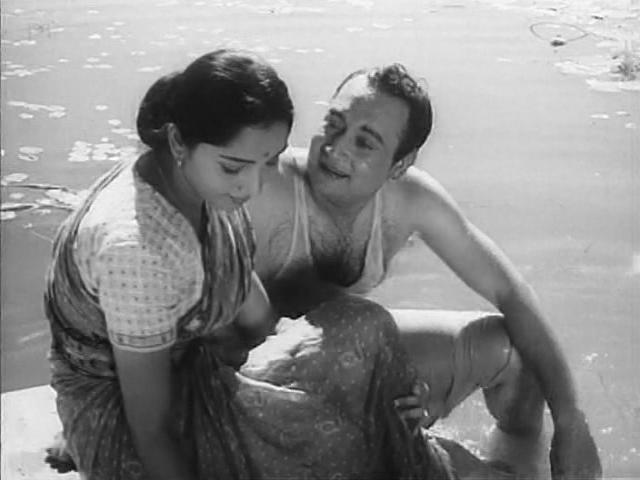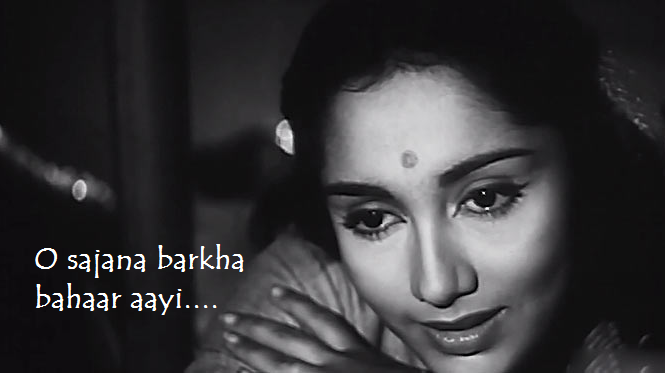Raaga Based Song of the Day: O sajana barkha bahaar aayi…
Raag Khammaj, Tal Kaherava
We have completed eleven days of Raaga Based Songs of the Day. Our first post in the series was titled ‘Raaga Based Song Of The Day #1’ and the song was a Mohammad Rafi and Lata Mangeshkar song from the 1970 Shakti Samanta movie Pagla Kahin Ka: Tum mujhe youn bhula na paoge. It is in Raag Jhinjhoti, Tal Kaherava.
Our eleventh post or the last post was titled ‘Raaga Based Song Of The Day #11’ and the song was a KL Saigal song from the 1938 Phani Majumdar movie Street Singer: Babul mora naihar chhooto hi jaye. It is in Raag Bhairavi, Tal Kaherava.
This blog has a number of posts on Raaga based songs in Hindi movies titled similarly; for example: ‘The Best Raaga Based Songs in Hindi Movies – Raaga Bhimpalasi – Part II’.
Finally after three days of heat in my home place Kandaghat in Shimla Hills, it rained today (7th June 17). Rains is my favourite season. It drenches everything including my heart and soul.
A few days ago I gave you a rain song in Raag Brindavan Sarang, Tal Tintal, Kaherava: Sawan aaye ya na aaye. For people in love, according to the song, when the heart dances with joy, it is Sawan.
Today’s song, from the 1960 Bimal Roy movie Parakh, which had a satirical story written by music director Salil Chowdhury, has an exactly opposite emotion about Sawan: that is, longing for one’s love.

And to help express these feelings appropriately, Salil da selected Raag Khammaj or Khamaj, a late evening raaga of Khamaj Thaat, and of romantic character. The Taal he used was Kaherava.
Some of Lata Mangeshkar‘s best songs are pictured on Sadhana and this is certainly the best.
This composition was thought of by Salil da when his car was caught in a sudden downpour and he heard the swishing of his car wipers. Indeed, this song’s rhythm comes closest to the feel of the pitter-patter of rain, especially in the antaras; eg, “Aise rimjhim mein ho sajan, pyaase pyaase mere nayan, tere hi khwaab mein kho gaye…”
Some of the other popular songs in Raag Khammaj are: Ab kya misaal doon, Ago kahan se Ghanshyam, Bada natkhat hai re Krishan Kanhaiya, Chunariya katati jaaye, Dhal chuki sham-e-gham, Khat likh de sanwariya ke naam babu, Kuchh to log kahenge, Mere to Giridhar Gopal, Nazar laagi raja tore bangle pe, Piya tose naina lage re, Sham dhale Jamuna kinaare and Vaishnava jan ko.
Value-added learning for today is about Khammaj Thaat to which the Raag belongs:
Because of being in Shringar Ras, the Raag is used in light classical forms of Indian Classical Music such as thumris, tappas, horis,and kajris.
If you look at the pictorial description of the Raag (it is on my blog), you will find it sensuous, even flirtatious.
Raagas in Khammaj Thaat include Rageshri, Jhinjhoti, Jaijaivanti, Des or Desh, and Tilak Kamod.
Please enjoy Lata Mangeshkar sing in Raag Khammaj, Tal Kaherava: O sajana barkha bahaar aayi…
(O sajanaa, barakhaa bahaara aaI
rasa kii phuhaara laaI, a.Nkhiyo.n me pyaar laaI ) – 2
o sajanaa
tumako pukaare mere mana kaa papiharaa – 2
miiThii miiThii aganii me.n, jale moraa jiyaraa
o sajanaa …
(aisI rimajhima me.n o saajan, pyaase pyaase mere nayana
tere hii, khvaaba me.n, kho gae ) – 2
saa.nvalii salonii ghaTaa, jaba jaba chhaaI – 2
a.Nkhiyo.n me.n rainaa gaI, nindiyaa na aaI
o sajanaa …
We have intended to learn about Raaga based music whilst we entertain ourselves with Raaga based songs. So, lets, once again, take stock of our collective learning so far:
- On the first day we learnt about the Raaga system devised by Pandit Vishnu Narayan Bhatkhande, which is the prevalent system in Hindustani Classical Music and based on ten Thaats.
- On the second day we learnt about Tal or Taal.
- On the third day we learnt about characteristics of Raagas that included Swar, Jati, Thaat, Arohana and Avarohana, Vadi, Samvadi and Pakad.
- On the fourth day, we learnt about Sargam.
- On the fifth day, we learnt about notations used in Indian classical music or simply Swar Lipi.
- On the sixth day, we learnt about the Ras (sentiments) that Raagas evoke.
- On the seventh day, we learnt about various types of Swar: Shuddha, Achal, Vikrut, Komal and Teevra.
- On the eighth day, we learnt the parts of a composition in Indian Classical Music.
- On the ninth day, we learnt the names of some of the popular instruments used in Indian Classical Music.
- On the tenth day, we learnt about the sources of names of Raagas.
- On the eleventh day, we learnt about why Bhairavi is the first raag to be taught to beginners and also why it is the last in a performance.
- And today, on the twelfth day, we learnt about Khammaj Thaat.
There is much more still to be learnt and enjoyed.
Please stay tuned!
